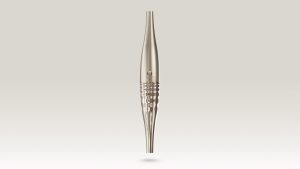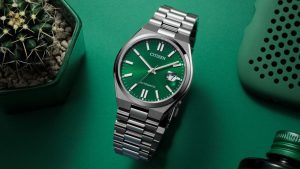[vc_row][vc_column][vc_column_text]Look good, feel good. From a young age, Julianne Costigan knew that fashion was more than clothing, it was self-expression.
“I always felt like I had a relationship with my clothing because I used it as a tool in my closet when I had a tough day,” says Costigan. “When I was in high school and had a presentation, I would put in that effort to think about what I was wearing, because I always felt like that made me feel more confident.”
She decided to pursue that passion at Ryerson University, where she studied fashion communication, which took her all the way to Paris to study at IFM and to Istituto Marangoni in London, England for a styling program.
In addition to her education, through working retail from the age of 15, Costigan built an understanding of how fashion could help increase a woman’s confidence. With her knowledge of design, texture and style, she’s helped dress the likes of tennis sensation Biana Andreescu, and country singer Meghan Patrick.
Now, the CEO and Creative Director of the Julianne Costigan brand wants to help women dress and feel their best, from the comfort of their own homes.
During a time when it may be easy to stay in your pajamas all day, Costigan says there value in continuing to get yourself ready for the day.
“I quickly saw a relationship between my productivity and what I wore. When I was wearing my sweatpants, I sat on the couch longer, I did my work on the couch with the TV on, I was not as quick at getting things done,” said Costigan. “When I got dressed and put a little bit of mascara on—because that’s what makes me feel good —and threw on a relaxed pair of denim versus my sweat pants, I just felt better and it was fun.”
With her newly released style guides, she shares her fashion knowledge with women everywhere, making it easier than ever to curate the wardrobe of your dreams. Filled with suggestions of the season’s latest trends and styled looks using staple pieces, the guides aim to encourage women to utilize their closets while helping navigate the overwhelming online shopping world.
For this week’s Women Who Lead spotlight, Bay Street Bull spoke with Julianne Costigan about dressing for success, the key items every woman needs in her closet and how to build a personal style.[/vc_column_text][vc_text_separator title=”Q&A” color=”custom” style=”double” border_width=”2″ accent_color=”#e0b5c8″][vc_column_text]

Fashion has always been something that’s been a big part of my life. Ever since the time I was young, I’ve always had an opinion on it. The only jobs I ever had growing up were in retail: first at American Eagle and then I worked my way up to high-end retail. I worked in a small boutique where I got very familiar with designer brands and working with the clientele that I ultimately work with now. So, when I was 15, I started working with them and getting to know who they were as women. That’s when I think I understood that every woman had a relationship with their clothing—at least those who value the clothing that they choose to purchase and wear every day and make a real effort.
During university, I worked under Zeina Esmail, and she was with an agency called Patron Management, so I got a lot of experience. When I finished university, I was signed on by that agency as a stylist and that’s where I really started my career in the industry. Last year, I decided to go off on my own, because I wanted to focus on working women and going back to sort of my roots and where I started in the industry because I just felt like that was where I felt most passionate and where I was really able to make a difference in people’s lives.
Why do you feel like it’s important to dress your best or put effort into how you’re presenting yourself to the world?
Because I know how it can make such a positive impact on your life. I truly believe that. I think everyone needs to have a style strategy and that’s what I help women with, creating a personal brand. For me, I’ve always seen the connection between style, confidence and success, both professionally and personally. I have days where I wear sweats around the house, of course, but do I feel better in my sweats when they are coordinated or matching? Absolutely. It’s not that I think everyone needs to wear a blazer and heels every day, but I think everyone can recognize how they feel about themselves, how they communicate with others and how other people communicate with them when they’ve taken a little bit of time and put an effort into what they look like. It changes how you feel about yourself and that really leads to success in so many other areas of your life.
I’ve seen firsthand how I have changed women’s lives and careers and helped them get that promotion or command authority in a workplace where it’s a male-dominated industry. Just by changing the way they dress affects how people communicate with them because all of a sudden they’re just looked at differently. People who maybe don’t raise their hand as often, are recognized all of a sudden. They’re showing up and people aren’t judging them because of what they’re wearing, they’re actually seeing them because of just small things they’ve done in their wardrobe that are ultimately a reflection of who they are as a person.
For example, I just worked with Tiffany Leigh. She has a beautiful aesthetic in interior design and I started working with her because she felt like she wanted her own personal brand. When she showed up at a person’s house, she wanted to look like the way that she could change their house. If she doesn’t look that way, then how are they going to believe that she can do that? I try and do that with every client I have. I help them establish goals and things that they want in their life, then I help them find clothing that I believe will get them there.
You kind of took the next question right out of my mouth. What kind of transformations do you see in your clients when you kind of help them find their own personal style and help them carve out a signature style?
I think Tiffany was a great example of that because her industry is so visual too. We recently did a blog post on her: Here’s an interior designer, here’s an interior she’s decorated, here are the pieces that we purchased. You can very quickly see how it feels like a reflection of that interior she had designed.
Similarly, women in the tech industry. For example, if she said, “Our atmosphere at work is very casual and I don’t want to be overdressed, but at the same time, I need to walk into a meeting and the investors to know that I’m the CEO because I’m young and I might dress like my employees, but I’m not an employee. I’m the CEO.” One of my first clients came to me with this exact problem. She said, “I went into a meeting with my assistant and the investor thought that my assistant was the CEO because we were both wearing like black skinny jeans and she happened to be a bit older than me.” And so that was a big problem.
When creating a style strategy, we talked about personality traits or things that she wanted people to see in her when she showed up to a meeting: command authority, a leader, bold or edgy. I took those personality traits and I thought about what textures and silhouettes would represent those things. Maybe it’s introducing more blazers with structured shoulders so that she stands taller. If she wants to be edgier, maybe we introduce some leather details because that’s a different texture than the average corporate woman. Making those connections and those subtle connections really ended up delivering a style strategy that we initially talk about.
As we continue to work from home, I feel like so many of us get stuck into that lull of sweatpants every day and not getting dressed. What would you suggest to women, who might not see the point in getting dressed for a Zoom call or always have their camera off because they’re still in their sleepwear?
I think we can’t be too hard on ourselves right now. The days when we’re not feeling great or you don’t want to be dressed, that’s fine. However, I do think that this is a really important time where we actually need to change out of our pajamas and establish a relationship with our clothing. Pajamas are there for sleeping and so you sleep in them. Then when you get up in the morning, you shower, and you put on something that looks a little bit more presentable.
At the beginning of quarantine, I did allow myself to wear sweats for a period of time—many days. I quickly saw a relationship between my productivity and what I wore. When I was wearing my sweatpants, I sat on the couch longer, I did my work on the couch with the TV on, I was not as quick at getting things done. But when I got dressed and put a little bit of mascara on—because that’s what makes me feel good —and threw on a relaxed pair of denim versus my sweat pants, I just felt better and it was fun. It made me happy to see myself in the mirror looking half presentable.
You could wear a coloured sweater—something that just feels a little bit more elevated and special. It could have a puff sleeve (a trend that we’re seeing right now), which is more fun than your hoodie, but it’s still the same comfort level. Then, on a Zoom call, you’re also going to send the message you want: you’re still working and you’re still productive.


Speaking of trends, what’s the difference between “style” and “trends” and why should you consider those when building a wardrobe?
Every client that comes to me says, “I want to start investing in the right pieces, but I don’t want a full designer wardrobe because that’s not how I want to spend my money. Can you show me how to spend my money properly to get the best use of it?” I have thought about myself almost as a fashion financial investor. I’m looking at someone’s lifestyle and I’m asking what’s important to you in the workplace, at home, in your life and then I help them spend their money in the areas where I think those investment pieces are going to last in their closet and stand the test of time. Pieces that are going to give them that confidence that they want and need.
Then we take a step back and say, “This is a trendy item right now, but it’s kind of fun and it would really elevate those more basic investment pieces that we’ve spent money on. It will freshen up those pieces that are going to live in your closet for 10, 20 years.” I am fully on board with trends, you just shouldn’t invest in or spend money on every trend. Choose a couple of trends each season.
Do you notice any common mistakes that clients make in their wardrobes? A common reason they’re not happy with their clothes?
I think a lot of people have way too much in their closet. I find the more you have, the less you wear because the abundance makes it confusing. You end up gravitating towards the same things every day because it’s easy. So, by eliminating some of the items in your closet that you never wear, or simply taking out of season clothes out of view, you create the space you need to see what you have. I think a lot of women struggle with that.
Also, a lot of women’s bodies have changed over time and I think they feel like they lose touch of, “How do I dress my body?” They don’t really feel good in anything, but they’re still wearing the same silhouettes they wore maybe 10 years ago or when they really focused on fashion. Now that they have children and families, fashion has become less of a priority for them and they need some expert help on how to feel good. For a lot of women, I help them get into new silhouettes and help them understand their body more and how to highlight the areas that they feel best about—that immediately brings confidence. It also helps them revive their wardrobe and feel in touch with the world and what’s going on in the fashion industry.
I think a lot of women just get stuck wearing sort of boring things and they never feel excited about what they’re wearing yet. I think I definitely teach women about their bodies and then help them get rid of the things that are no longer working for them or are weighing their closet down.
You recently launched the digital style guides, can you explain how those work?
We launched this digital style guide because we were listening to the consumers and clients and followers on Instagram. We noticed a common trend: they were having a hard time navigating the online shopping world and the abundance of options available. They wanted to be more thoughtful about what they were wearing or purchasing and eliminate waste. A lot of women order things and then get too lazy to ship them back because it feels too complicated or it’s another thing on their to-do list. So, we created this because we wanted to help women become better online shoppers.
What we didn’t anticipate was that we would actually provide a style guide and allow these women to find hidden pieces in their closet and reinvent them based on how we’ve shown them. How we’ve created the digital style guides, is with a mood board where women can see real women in the streets wearing real things, real body types, and with a general color palette and using pieces that are similar to what we’re recommending. Then, we provide a shopping list with roughly 20 items.


We’re not trying to tell women they need to buy 20 items. We’re just saying here are 20 items that are great and they work together. We thought women would buy a couple of things, but also hopefully use their own closet and rediscover how they could wear something in a new way. The next part is we put 30 outfits together: one outfit a day for a month using the pieces, and we also introduce pieces from previous issues. So, we’re showing women how to continuously use pieces from the previous issues in their closet.
We also do a zoom call once a month where I answer their questions about what they’re buying and enjoying. I bring on an expert, either a designer or someone in the industry, and we have a conversation and we talk about things. So it’s become this little sort of a community of women who love fashion and want to learn more. It’s kind of like a stylist without the price tag. It just launched in October, but we’ve seen women opening our guide over a hundred times in a month. So, that’s like three to four times a day, meaning they’re going back to it, not just to shop, they’re going back to it, to read how to wear things. People are printing it off, putting it in their closet and using it as a way to feel inspired to shop their closet and wear the clothes that they already have. So it’s been positive and really cool.
The membership is growing and we are excited to build a community of women who we can connect with. I’ve always thought, “Oh, I wish I could be in multiple places at once.” And this has allowed me to work with hundreds of women at one time without having to physically be there with them. So, I love that part about it and it’s something I’m really proud of.
How would you describe your own personal style?
I would say my personal style is an amalgamation of the classic and the trendy. To create a meaningful capsule wardrobe, I like to invest in elevated classic pieces that are enduring as trends evolve season after season. I love combining classic pieces with high-street and mainstream fashion brands to create unique looks in this way. You’ll find that many of my looks also incorporate bold colours and fun and interesting textures; they add depth and help me to tell a story through style.
What are three items should every woman have in her wardrobe?
1) A blazer. That is definitely something that I make sure all of my clients have: an amazing blazer that makes them feel great. I think a blazer can take you anywhere and blazers are so fun now. Twenty years ago, they were boring, ill-fitting, boxy things that we’re just trying to replicate what a man wore, but now there are so many fun colors and textures and things you can do.
2) A white-collared shirt.
3) A pair of dark denim or a great black pant.
That’s a uniform that I truly believe you can go anywhere in. By changing up the shoe or the accessory, it can go from day to night, very easily. A blazer, great fitted pants and a white-collared shirt. You can pack that in the suitcase, get on a plane and no matter where you’re going you’ll look great and feel confident.
If you were to give advice to your younger self, what would you say?
Something I was taught and I would teach my future children is that hard work is always the most important thing. I think work ethic is something you’re always in charge of. You’re capable of working hard and no one can take that away from you. That’s how you get places and get to where you want to be, by working hard.
So, I’d tell myself to just keep working hard. Also, always take the higher road. I think that’s an important part of life, both personally and professionally. I think taking the higher road always gets you where you want to go. [/vc_column_text][vc_separator color=”custom” style=”double” border_width=”2″ accent_color=”#e0b5c8″][/vc_column][/vc_row]













